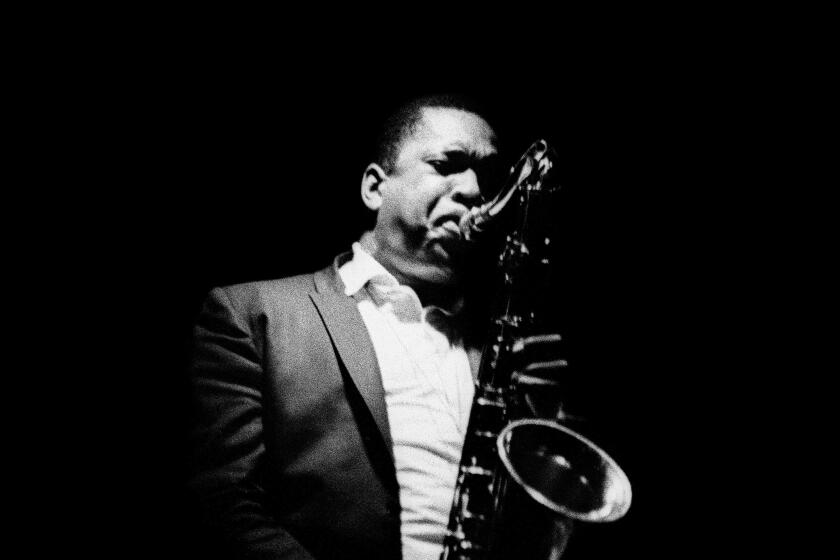True to Tudor?
- Share via
It was a new day. It was, for all intents and purposes, a new art form.
The 1942 premiere of Antony Tudor’s ballet “Pillar of Fire” drew the New York cognoscenti -- not just the audience that turned out for dance spectacles like “Swan Lake” but one that would attend a Eugene O’Neill play, a De Kooning gallery show or a Dylan Thomas reading.
On Thursday night, American Ballet Theatre will open a nine-day run at the Dorothy Chandler Pavilion with the British choreographer’s signature work as part of a mixed bill that will be repeated three times. Some may view the ballet as an antique.
But 62 years ago, on the company’s second anniversary, “Pillar” was a groundbreaking experiment in dance -- one that brought a contemporary sensibility to the stage, that told of ordinary people with specific psycho-social dimensions, not courtly characters or fairy tale creatures as seen through the prism of melodrama and mime.
What’s more, the music was Arnold Schoenberg’s “Verklarte Nacht” (Transfigured Night), a landmark score, first performed in 1903, that shattered the tonal universe and exploded in a symphonic sweep of overripe passions, searing conflict and extraordinary tenderness. But moving to it required dancers not to count beats but instead to learn long-breathed phrases.
Tudor’s scenario for “Pillar of Fire” centered on Hagar, a woman shrouded in Victorian shame, anguishing over a Calvinist split in matters of sex and spirituality, trapped between social constraints and longings for love.
Not exactly ballet fare as anyone knew it.
Yet Tudor, Ballet Theatre’s founding choreographer and a bona fide playwright of the dance, saw fertile turf in this subject. So did the connoisseurs at “Pillar’s” premiere. Critic Alan Rich, who attended opening night and witnessed its 30 curtain calls, says, “I did not speak for a week.” A recording of the Schoenberg music issued shortly afterward featured on its cover a photo of Tudor’s ballet.
Against all odds, it was a popular and critical hit.
Tudor’s ballets have been on the back burner. Abstract works, pop-oriented displays, choreographed acrobatics and full-length extravaganzas take center stage at most dance companies. So this revival of “Pillar,” the first since 1990, has been eagerly awaited.
But ballet revivals depend not so much on the kindness of strangers as on the artistic fidelity of producers. Will the effort be a labor of love or an obligation carried out? And how durable can a work be without the supervision of its creator or a stand-in who learned at his or her side?
Amanda McKerrow, the 39-year-old ABT principal scheduled to dance the role of Hagar on Thursday, certainly faces these questions. But at least she can claim a direct line to the choreographer, who coached her in 1982 in another of the ballet’s roles and again for a month in 1987, until the day before he died.
As do most others who had contact with him, McKerrow calls her mentor “Mr. Tudor” and speaks of being “thrilled and shocked” that he wanted her to learn the Younger Sister, the provocative-coquette part. “ ‘Don’t act like a little girl,’ he told me. ‘Do the choreography the way I give it, and you’ll be a little girl.’ Everything I needed to know about the character, he said, was in the choreography.”
But 45 years earlier, when he coached Annabelle Lyon as the first Younger Sister, Tudor’s suggestions were far more detailed: He told Lyon how to be kittenish by looking up from under her eyelashes and to catch the great French actress Simone Simon, who was then appearing on Broadway, for a live example.
“Pillar” is a period piece set in roughly the same era as William Wyler’s movie “The Heiress,” based on Henry James’ novel “Washington Square.” When we see that film now, however, the actors’ potency is preserved on celluloid. A stage revival offers no such guarantees.
That may be especially true when it comes to “Pillar of Fire,” with its old-fashioned decor. Here the strength of a portrayal depends on inner motivation and not what the dance-maker called “ham acting.” McKerrow remembers how Kathleen Moore, the last Hagar whom Tudor coached, struggled. “He insisted that she hold all the tension in her body throughout. There are only a few moments where you get to let it go.”
Writing about the great dramatic ballerina Nora Kaye, his first Hagar, Tudor said that he choreographed on her defects: “She didn’t have a beautiful line but possessed a powerful armature that could project rigid strength.” It’s that elusive quality that the lyrically inclined McKerrow says she strives for in the role. In her mind, finding it is more to the point than whether the theme of sexual repression is still relevant.
McKerrow believes that Tudor’s movements are so true and so telling of inner states that a dancer has only to learn them fully to keep his works vital.
If “Pillar” was performed without its period costumes and specific sets, McKerrow says, it would be just as powerful.
“We have to hope we can honor his work,” she says. “It is universal and timeless.”
Perlmutter is the author of “Shadowplay: The Life of Antony Tudor.”
*
American Ballet Theatre Mixed Repertory
Where: Dorothy Chandler Pavilion, 135 N. Grand Ave., L.A.
When: Thursday, 7:30 p.m.; Friday, Tuesday and Wednesday, 8 p.m.
Price: $25-$85
Contact: (213) 365-3500
More to Read
The biggest entertainment stories
Get our big stories about Hollywood, film, television, music, arts, culture and more right in your inbox as soon as they publish.
You may occasionally receive promotional content from the Los Angeles Times.










